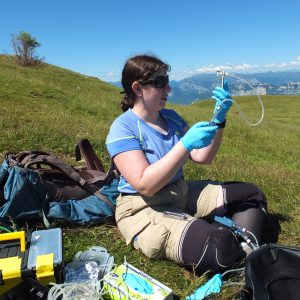Dr Kelsey J.R.P. Byers
Group Leader Building Robustness in Crops (BRiC), Harnessing Biosynthesis for Sustainable Food and Health (HBio)
How does floral scent influence the evolution of flowering plants?
The vast majority of flowering plants rely on animal pollination to spread their pollen to other individuals of the same species.
How do plants attract pollinators, and how do they make sure their pollen gets to the correct species?
Flowers use many traits to influence animal pollinator visitation, including colour, shape, and scent. By making sure that the “right” pollinators visit in the right way, plants can ensure that their pollen is successfully transferred.
The Byers Group studies the evolution and diversification of floral scent at a wide range of scales, from genus-wide evolutionary patterns (lots of species) to floral scent evolution of pairs of species with different pollination systems (e.g. hummingbird versus bumblebee).
To further knowledge in this topic, they use approaches ranging from genetic mapping and manipulation of floral scent genes through to behavioural experiments with large plant arrays in greenhouse conditions.
They are also investigating how floral scent genes evolve in natural populations. At present research focuses primarily on monkeyflowers in the genus Mimulus (also known as Diplacus and Erythranthe), a developing model system in evolutionary biology.
Work on the fragrant orchid genus Gymnadenia will focus on the integration of different floral traits (morphology, color, pigments, scent) in hybrids between two very distinct species.
Selected Publications
-
Byers K (2021)As if they discovered it by the scent: improving our understanding of the chemical ecology, evolution, and genetics of floral scent and its role in pollinationAmerican Journal of Botany (108)
-
Byers K,Bradshaw HD (2021)Rational design of a novel hawkmoth pollinator interaction in Mimulus section ErythrantheFrontiers in Ecology and Evolution (9)Publisher's version: 2296701X
Opportunities
Informal enquiries to join the Byers group are welcome.
